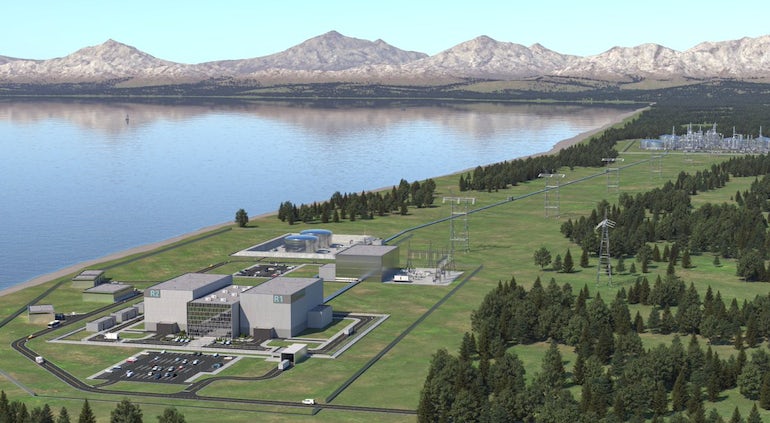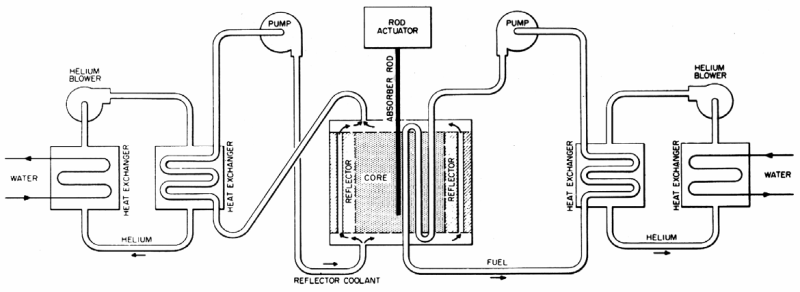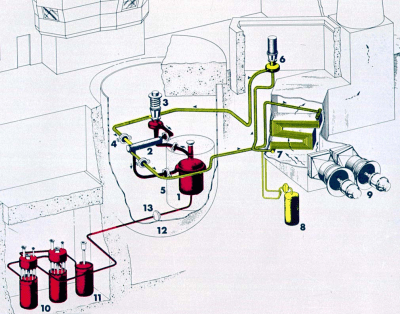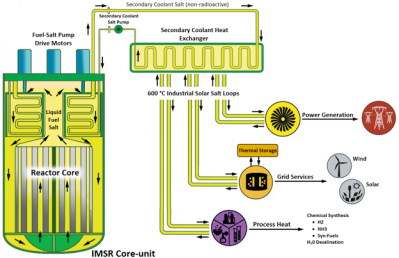
Although to most the term ‘fission reactor’ brings to mind something close to the commonly operated light-water reactors (LWRs) which operate using plain water (H2O) as coolant and with sluggish, thermal neutrons, there are a dizzying number of other designs possible. Some of these have been in use for decades, like Canada’s heavy water (D2O) reactors (CANDU), while others are only now beginning to take their first step towards commercialization.
These include helium-cooled, high-temperature reactors like China’s HTR-PM, but also a relatively uncommon type developed by Terrestrial Energy, called the Integral Molten Salt Reactor (IMSR). This Canadian company recently passed phase 2 of the Canadian Nuclear Safety Commission’s (CNSC) pre-licensing vendor review. What makes the IMSR so interesting is that as the name suggests, it uses molten salts: both for coolant and the low-enriched uranium fuel, while also breeding fuel from fertile isotopes that would leave an LWR as part of its spent fuel.
So why would you want your fuel to be fluid rather than a solid pellet like in most reactors today?
Historical Lessons

Even though many newly licensed or about-to-be-licensed reactor designs in the 2020s sound futuristic, virtually all of them have been conceptualized in some form or shape before the 1960s, and many have had prototypes built. So too for molten salt reactors (MSRs), which saw Oak Ridge National Laboratory (ORNL) create a number of prototypes, starting in 1954 when the Aircraft Reactor Experiment (ARE) reached first criticality. ARE was an off-shoot of the Aircraft Nuclear Propulsion (ANP) program that had its roots in the US Air Force, before it was transferred to the Atomic Energy Commission (AEC).

From there the project ended up at ORNL, where the original solid fuel design was changed into a molten salt/fuel mixture due to concerns over reaction stability at high temperatures, which the MSR design might solve. After the cancellation of the ANP program the MSR technologies from ARE and subsequent designs were used for a purely civilian project: the Molten-Salt Reactor Experiment (MSRE).
Like the ARE, MSRE used molten fuel, albeit with a different composition. ARE used 53.09 mole % NaF, 40.73 mole % ZrF4, and 6.18 mole % UF4 for its salt/fuel mixture, with uranium-235 as the fissile material. The neutron moderator also changed from beryllium oxide (BeO) in ARE to pyrolitic graphite in MSRE.
MSRE used 7LiF – BeF2 – ZrF4 – UF4 (65 – 29.1 – 5-0.9 mole %) following lessons learned from the ARE salt mixture. Initially 33% (enriched) uranium-235 was used in its primary coolant/fuel mixture, before switching to using uranium-233 bred from thorium in breeder reactors. Although it would have been possible to configure MSRE to use thorium salts to breed its own fuel from, this was omitted for the experiments, with instead neutron measurements being performed. This does however touch on one of the benefits of an MSR, in that they can be a fast neutron reactor unlike a water-moderated LWR, making them capable of breeding their own fuel from fertile isotopes, including the transuranics and actinides resulting from the original uranium fuel. The other advantage of MSRs is that they can operate at very high temperatures (820 °C for ARE, 650 °C for MSRE) due to the high thermal stability and heat capacity of the coolant, while not requiring the pressures seen with pressurized light water reactors (PWRs), which typically feature a outlet temperature of around 300 °C.
The operating temperature ultimately determines what processes and turbines it is compatible with, as industrial processes often require temperatures far above what LWRs can deliver. An MSR capable of providing a constant source of >600 °C heat would be exceedingly practical for these applications, as well as increase the thermal efficiency of electricity generation via steam turbines.
Over the course of the MSRE’s five-year lifespan, it provided significant information on the behavior of both 235U and 233U fuel, as well as the production and handling of xenon gas (a neutron poison), the stability of the graphite moderator and the immunity of the used salt to any kind of radiation it was exposed to. It also validated the new metal alloy developed at ORNL to resist the corrosive effects of the hot salt, which is a nickel-chromium-molybdenum called Hastelloy N.
When the MSRE was shutdown in 1969 for decommissioning, one unexpected finding that was that of embrittlement of the metal exposed to the salt, which was traced back to tellurium, one of the fission products. This finding led to an adjustment of the Hastelloy N alloy, to counteract these effects. Yet despite these successes, the US would virtually abandon further development in MSRs, despite ORNL creating a number of follow-up designs.
The use of salts as coolant would however continue worldwide, mostly for fast neutron reactors, with examples like the Russian BN-series of sodium-cooled, fast neutron reactors being prime example of this. Although they use solid fuel, they demonstrate the viability of long-term use of corrosive, hot salt as coolant, with the BN-600 operating since 1980. The similar US EBR-II operated from 1964 to 1994, including simulated emergencies like a sudden shutdown at full power, demonstrating the passive safety of these pool-type sodium-cooled reactors, much of which also applies to MSRs.
The Integral MSR

The Terrestrial Energy’s IMSR is a fully self-contained MSR, with the molten salt, the pumps, primary loop and graphite moderators are contained within what Terrestrial Energy calls the IMSR Core-unit. With a single Core-unit producing 440 MW thermal (MWth) and a claimed 44% thermal efficiency when generating electrical power due to the 700 °C outlet temperature, allowing a plant with a single Core-unit to generate around 390 MWe, with the remaining heat being used for cogenerating purposes (e.g. heating). Other uses are for the aforementioned process heat, thermal (salt) storage, etc.
What is interesting about the IMSR is that it is a purely thermal spectrum Generation IV reactor, despite using molten salt fuel. This fuel itself is standard low-enriched uranium (LEU) at <5% 235U, the same as used in virtually every commercial reactor in use today. There are no fast neutrons being used to breed fuel from fertile fission products or thorium salts – with the graphite moderator moderating all fast neutrons to thermal neutrons – making it very much akin to an LWR. The advantages of using molten salt here come mostly from the much higher heat capacity at ambient pressure, as well as online refueling, with each Core-unit expected to remain in 24/7 operation for seven years. During this time fresh fuel is gradually added to the primary loop to maintain reactivity.
After the operational time is over, the entire (sealed) unit is left to cool off for a while before it is returned to the factory for recycling. This means far less stringent requirements for the operator, as the unit is essentially maintenance-free, which is part of Terrestrial Energy’s pitch towards commercialization. Such a focus on simplicity of operation is popular with small modular reactor manufacturers – including GE-Hitachi’s BWRX-300, which is a more conventional boiling water reactor (BWR) type LWR – but also with a range of other upcoming MSRs.
Compact, Safe, And Hot
Perhaps unsurprisingly, the IMSR isn’t the only MSR in town today, with a few more contenders looking to commercialize their own designs over the coming years. These include the Danish Seaborg Compact Molten Salt Reactor (CMSR), the Moltex Stable Salt Reactor (SSR) and a number of designs that also use salt as coolant, but with solid fuel such as the TerraPower Natrium and Kairos Power KP-FHR, What’s also interesting is how unique each design is.
The IMSR, for example, is designed to fit in with a more LWR-like once-through fuel cycle (following ORNL’s denatured MSR design), just much more convenient, more compact and with much higher temperatures. The CMSR meanwhile does not use a graphite moderator, but sodium hydroxide in parallel tubing, which makes the design even more compact and adjusting the neutron moderation easier. The SSR does not target the use of thermal neutrons alone, but also fast neutrons in its SSR-W configuration, for ‘wasteburner’. This uses liquid fuel rods, suspended in a salt coolant pool, that would use spent fuel reprocessing remnants (like actinides) for its fuel, along with plutonium, MOX fuel and so on, befitting the name.
Although MSRs have the potential to be refueled continuously without shutting them down, this is not a common design feature yet. Even so MSRs and similar high-temperature reactors are likely to become a common sight over the next years, with larger reactor types on the scale of traditional LWRs (1+ GWe) an interesting prospect, especially if they are operated in a fast neutron configuration, able to use both spent LWR fuel and fertile isotopes like thorium.
Regardless of the exact configuration, MSRs have the intrinsic safety feature of a negative fuel temperature coefficient, meaning that the reactivity of the fission process is inversely linked to the temperature of the salt coolant. This makes an MSR not only intrinsically resistant to high reactivity events, but also of load-following, as the extraction of heat from the secondary cooling loop immediately impacts the core’s reactivity.
It’s hard to believe that it’s been seventy-odd years since ARE’s first test run, but as this decade dozens of MSRs go into commercial service, it should feel as validation for the researchers at ORNL and colleagues for all the work they put into making molten salt work as reactor coolant as well as fuel.
(Heading image: IMSR plant as imagined by Terrestrial Energy. (Credit: Terrestrial Energy) )
